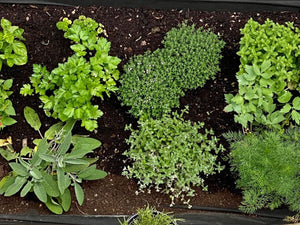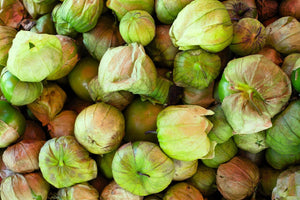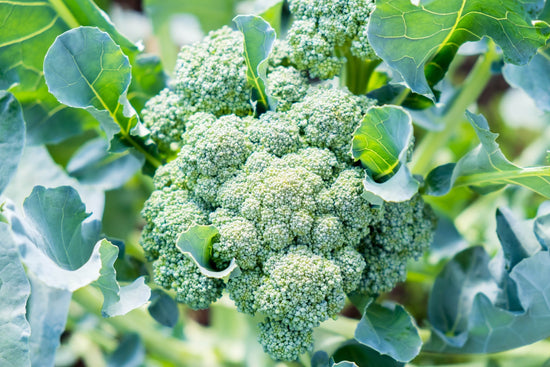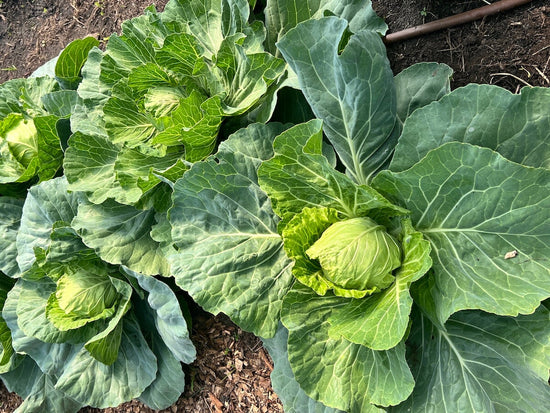Growing Your Own Brussels Sprouts from Seed: A Step-by-Step Guide
Brussels sproutsBrussels sprouts are a nutritious and delicious vegetable. You're missing out if you haven't eaten a fresh, home-grown sprout! They thrive in cooler temperatures, making them ideal for fall harvests or early spring planting. Because of their long maturation period, having the right growing strategies is crucial for a successful harvest. This article will help you navigate step-by-step, from seed germination to special care throughout the growing season and when to harvest for the best flavor.

Brussels sprouts are members of the brassica family and have growing requirements similar to broccoli and cabbage. But these “miniature cabbages” have a flavor all their own. If you want the best-tasting Brussels sprouts, try growing them in cool weather and harvesting them after a frost. The cold snap will make the flavor even sweeter, and you’ll be rewarded for your gardening patience.
Long Island Improved Brussels Sprouts is a favorite heirloom variety from the 1890s. The plant grows 20 to 24 inches tall and produces heavy yields of one-inch sprouts. Days to maturity is about 90. Long Island Improved Brussels sprouts are great for small spaces or containers.
How to Grow Brussels Sprouts from Seed
Knowing the average temperatures in your growing zone will help you plan the right time to plant Brussels sprouts.
Brussels sprouts take about four to six weeks indoors to be ready for transplanting outdoors. After transplanting, they take 90 to 110 days to fully mature. With this in mind, you can plan when to start your Brussels sprout seeds.
Starting seeds indoors is the best way to sow brussel sprout seeds. This approach not only caters to the long growing season of Brussels sprouts but also helps establish strong and vigorous seedlings well before planting time.
To maximize the health of your sprouts, it's vital to maintain even moisture and provide ample light for the young seedlings; this ensures that they grow stocky and robust, sidestepping issues with weak, elongated stems known as "legginess."
With their preference for cooler climates, Brussels sprouts are surprisingly resilient to cold temperatures, even during germination. Seeds can successfully germinate in conditions as chilly as 45ºF.
Tips for fail-proof Brussels sprouts seed germination
Sow seeds indoors 4 to 6 weeks before transplanting.
Plant seeds 1/4” deep.
The optimal soil temperature for germination is 60-70ºF, but they can germinate in temperatures as low as 45ºF.
Keep seeds moist.
Use bottom watering to keep the soil moist and leaves dry.
Grow lights placed a few inches above the seedlings will help prevent legginess.
A heat mat is unnecessary as warm temperatures can contribute to leggy seedlings.

Transplanting Brussels Sprouts Seedlings
Around four to six weeks after planting Brussels sprout seeds, the seedlings should be ready for transplanting outdoors. By this time, they should have four or five true leaves and a well-developed root system.
Harden off Brussels sprouts seedlings gradually. Over the course of a week, expose them to outdoor conditions before transplanting.
Space seedlings 18 to 24 inches apart. Give them room to grow and room for airflow. In a square foot garden, Brussels sprouts plants take up 2 square feet.
Plant in a spot where you haven’t grown other brassicas for at least a year. A four-year crop rotation plan is even better.
Place the Brussels sprout seedling in the hole and plant to the same depth it was already growing. Firmly press the soil around the roots to eliminate air pockets. Water well.
Transplant seedlings out 90 to 100 days before the first frost. This allows them to grow faster during warm days and then slow down and finish developing before you harvest after a few frosts.

How to Grow Brussels Sprouts Plants
The sprouts we eat are small heads that look like cabbages and form on a stalk. The taller the stalk, the more room for heads to form. Growing big plants will result in a larger harvest.
Plan on having these plants take up garden space for a long time. Consider growing them as part of your landscaping.
Soil
Growing healthy Brussels sprouts starts with nutrient-rich soil that has been amended with plenty of organic material. The soil should be well-draining with a pH of 6 to 7.
Sun
Full sun, meaning at least 6 hours, is needed for optimal vegetable production. In very warm climates, afternoon shade is okay.
Fertilizing
Start with healthy, nutrient-rich soil and then apply additional nitrogen to promote leafy growth when plants start growing. Keep nitrogen levels consistent to avoid growth that is too fast, which could result in loose heads.
Watering
Use consistent watering methods to keep the soil moist. Applying a layer of mulch can conserve moisture and keep the soil cool. Dry periods can result in head splitting and a bitter taste. You may need to water more during hot, dry days.
Temperatures
Temperature is a crucial factor in the growth and flavor of Brussels sprouts. Brussels sprouts grow fast in warm temperatures and slowly in cooler temperatures. They can grow in temperatures above 40ºF and below 95ºF. The optimal temperature for growing Brussels sprouts is around 75ºF. Plan for your main growing days to be when that is the average temperature.
Brussels sprouts can take 120 days to mature. The average is 90 to 110 days from transplanting.
In some locations, seedlings are planted out in midsummer, and sprouts are harvested into early December. In areas with cool summers, you can grow through the summer months.
When temperatures go below 40ºF, the plants will be fine; however, they won’t be growing and producing. But you can leave them in the ground and continue to wait until the first frost to harvest. Cool temperatures result in a sweeter flavor, and the texture will remain crisp as long as temperatures don’t fall below 20ºF.
Intercropping and Companion Planting
To make the most of your garden space, you can intercrop and companion plant. The leaves can get large and shade out plants, but early in the season, you can plant radishes and other crops that mature quickly.
Nasturtiums and other companion plants can help control pest populations.

Pruning and Topping
Pruning and topping are not required for Brussels sprout plants.
You can top off Brussels sprout plants a few weeks before the end of the growing season.
Cutting off the top 2 or 3 inches of the plant will keep it from continuing to grow upwards and instead put its energy into forming heads already on the stalk.
This can be important when cold weather is approaching, and you want the plants to mature for harvesting. (Or warm weather, depending on which season you are growing in.)
It is not necessary to prune the leaves on the stalk. But you will want to remove leaves that have started to turn yellow.
Solutions for Brussel Sprout Pests and Diseases
Cabbage moths and aphids are common pests that love to feast on Brussels sprouts.
Timing helps to mitigate pest problems. The cooler temperatures result in less aphids and worms.
Floating row covers are an excellent way to prevent these pests. As soon as you put out transplants, cover them with row covers. Brussels sprouts don’t need pollination, so it’s okay to keep them covered.
You can use collars around the stalks and baits for slugs and snails.
Rotate crops and don’t plant in the same space where you grew other cole crops, such as cabbage, cauliflowers, and broccoli.

When and How to Harvest Brussels Sprouts for the Best Flavor
To capture the hallmark flavor of Brussels sprouts—complex, earthy, and with a hint of sweetness—it's critical to know the best harvesting practices.
The little heads mature from the bottom of the plant to the top. So you can start picking the ones off the bottom of the stem first. Twist the sprouts to pull them off the stalk.
Aim to pluck the sprouts when they are 1.5 to 2 inches in diameter, similar to the circumference of a quarter. This ensures that the sprouts are perfectly sized for the most palatable experience.
Harvest your Brussels sprouts after they've had at least one light frost. This will improve the flavor for more sweetness and less bitterness.
You can harvest individual heads or cut the whole stalk. The stalks can get hard, and you may need to use tree pruners or loppers to cut them.
At the end of your growing season, cut the top few inches of the top of the plant. This will stop the upward growth and encourage the small heads to continue developing. Topping the plant will also help the Brussels sprouts be more uniform on the whole stalk. This is especially helpful if you want to harvest the entire stalk at once. Cut off the top 3 to 4 weeks before you want to harvest. If you aren’t concerned about harvesting all at once, start harvesting the bottom sprouts when they are 1 to 2 inches in diameter.
Don’t take the leaves off until you are harvesting the sprouts. You can remove the bottom leaves as you remove the bottom sprouts. Leave about 2 inches of leaf stalk.
When temperatures remain at 20ºF, the plants will stop producing. So you can plan ahead and top off the plants.
Mature Brussels sprout plants can withstand a light freeze. You can even harvest Brussels sprouts after it snows! As long as temperatures are above 20ºF, the taste and texture will be fine.
Besides harvesting at the right time, cooking them the right way makes a huge difference. Roasted Brussels sprouts with a little olive oil or bacon grease is a delicious way to enjoy this nutritious vegetable.

Brussels Sprouts FAQs
Can you eat the large flat leaves on Brussels sprout stalks?
Yes. These leaves are edible and can be cooked like you would collard greens.
How long do Brussels sprouts take to grow?
Brussels sprouts can take 90 to 120 days to mature.
Do Brussels sprouts come back every year?
Brussels sprouts do not come back. You will need to sow seeds each season.
Are Brussels sprouts hard to grow?
They aren’t particularly hard to grow, but the secret to success is growing them in cool temperatures and providing enough nutrients and water.
How many Brussels sprouts will I get from one plant?
One stalk can have an average of 45 to 60 sprouts.
What month do you plant Brussels sprouts?
Planning the best time to plant Brussels sprouts depends on your growing conditions, specifically temperatures. These cool-weather crops will grow best when temperatures are between 40 and 85ºF. So plan accordingly. For example, in growing zone 7a, you might start seeds indoors in May and transplant out seedlings in June for a fall to early winter harvest. October might be the best time to put out transplants in warmer climates.
Is it brussel sprout or Brussels Sprouts?
The name is Brussels sprouts. They are believed to have originated in Brussels, Belgium.
While Brussels sprouts may require a longer growing season and some extra attention, they will reward you with a fresh taste you can’t get at the grocery store.
You can enjoy a bountiful harvest of firm, green sprouts by planting Brussels sprouts from seed at the right time, keeping them cool and well-watered, and protecting them from pests. With a little effort and care, you can add this versatile and nutritious vegetable to your home garden and enjoy the satisfaction of growing your own food.
Give Brussels sprouts a try this season and reap the delicious rewards!
Popular Posts
-

Our Favorite Herbs to Plant in Fall for a Flavorful Harvest
-

Master Gardener Tips to Grow Buckets of Tomatillos for Salsa Verde






Leave a comment